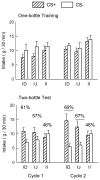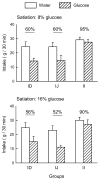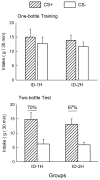Post-oral infusion sites that support glucose-conditioned flavor preferences in rats
- PMID: 20026145
- PMCID: PMC2813956
- DOI: 10.1016/j.physbeh.2009.12.012
Post-oral infusion sites that support glucose-conditioned flavor preferences in rats
Abstract
Rats learn to prefer a flavored solution (CS+) paired with a gastrointestinal glucose infusion over an alternate flavor (CS-) paired with a non-caloric infusion. Prior work implicates a post-gastric site of glucose action, which is the focus of this study. In Exp. 1, male rats (8-10/group) were infused in the duodenum (ID), mid-jejunum (IJ), or distal ileum (II) with 8% glucose or water as they drank saccharin-sweetened CS+ and CS- solutions, respectively, in one-bottle 30-min sessions. Two-bottle tests (no infusions) were followed by a second train-test cycle. By the second test, the ID and IJ groups preferred the CS+ (69%, 67%) to the CS- but the II group did not (48%). Satiation tests showed that ID and IJ infusions of glucose reduced intake of a palatable solution similarly, while II infusions were ineffective. In Exp. 2, rats (10/group) drank CS solutions in one-bottle, 30-min sessions and were given 2-h ID or hepatic portal vein (HP) infusions. The CS+ and CS- were paired with 10 ml infusions of 10% glucose and 0.9% saline, respectively. Following 8 training sessions, the ID group preferred the CS+ (67%) to the CS- but the HP group did not (47%) in a two-bottle test. The similar CS+ preferences displayed by ID and IJ, but not II groups implicate the jejunum as a critical site for glucose-conditioned preferences. A pre-absorptive glucose action is indicated by the CS+ preference displayed by ID but not HP rats in Exp. 2. Our data were obtained with non-nutritive CS solutions. HP glucose infusions are reported to condition preferences for a flavored food that itself has pre- and post-absorptive actions. Thus, there may be multiple sites for glucose conditioning with the upper or mid-intestines being the first site of action.
Copyright (c) 2009 Elsevier Inc. All rights reserved.
Figures



References
-
- Ackroff K, Sclafani A, Axen KV. Diabetic rats prefer glucose-paired flavors over fructose-paired flavors. Appetite. 1997;28:73–83. - PubMed
-
- Ackroff K, Touzani K, Peets TK, Sclafani A. Flavor preferences conditioned by intragastric fructose and glucose: differences in reinforcement potency. Physiol Behav. 2001;72:691–703. - PubMed
-
- Ackroff K, Sclafani A. Flavor quality and ethanol concentration affect ethanol-conditioned flavor preferences. Pharmacol Biochem Behav. 2002;74:229–40. - PubMed
-
- Ackroff K, Sclafani A. Fructose conditioned flavor preferences in male and female rats: effects of sweet taste and sugar concentration. Appetite. 2004;42:287–97. - PubMed
Publication types
MeSH terms
Substances
Grants and funding
LinkOut - more resources
Full Text Sources
Research Materials
Miscellaneous

